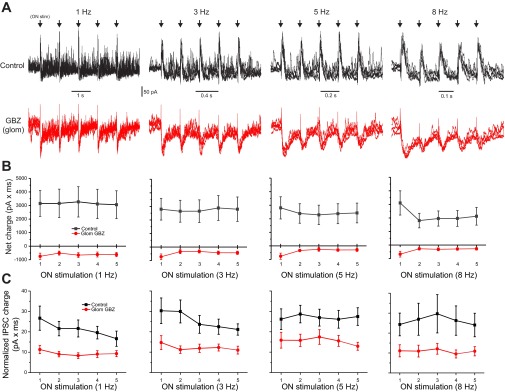Fig. 1.

Mitral cell (MC) inhibitory postsynaptic current (IPSC)/excitatory postsynaptic current (EPSC) responses to olfactory nerve (ON) input at frequencies from 1 to 8 Hz are invariant. A: voltage-clamp recording (holding potential = −10 mV) of a MC in artificial cerebral spinal fluid (aCSF; top, black) and following glomerular restricted application of 100 μM gabazine (GBZ; bottom, red). ON stimulation at 1, 3, 5, and 8 Hz (arrows) produced a rapid onset barrage of IPSCs followed by lower frequency intermittent IPSCs. Note, the x-axis scale in each panel is different to maintain stimulation spacing constant. B: population average of MC “early” net charge (pA × ms) at each ON input frequency in aCSF (black, n = 8 cells) and following application of GBZ (red). Addition of glomerular GBZ abolishes early inhibitory currents and unmasks a small excitatory current. C: population average of MC “late” IPSC charge at each ON stimulation frequency. Although, variability between cells in late IPSCs is higher than in early IPSCs, no significant differences with late IPSCs were observed across ON stimulations from 1 to 8 Hz. Addition of GBZ attenuates late IPSCs ∼50%.
